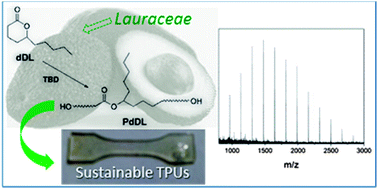Thermoplastic polyurethane elastomers from bio-based poly(δ-decalactone) diols†
Abstract
Bio-based poly(δ-decalactone) is an amorphous, low glass transition temperature (Tg) material and it is an aliphatic polyester (Martello et al., ACS Macro Lett., 2011) that can be utilized as a soft segment in thermoplastic polyurethanes (TPU). We describe the synthesis and purification of low molar mass poly(δ-decalactone) diols (PdDL), as well as the synthesis and characterization of new PdDL-based TPUs. The PdDLs obtained were characterized by proton nuclear magnetic resonance (1H-NMR) spectroscopy and matrix-assisted laser desorption ionization mass spectroscopy. Three different PdDLs were prepared and their molar masses calculated from 1H-NMR spectroscopy were: Mn ≈ 1300, 1800 and 2700 g mol−1. These three PdDLs were reacted with 4,4′-methylenebis(phenyl isocyanate) and two different chain extenders (1,4-butanediol and water), to synthesize polyester-based TPUs. The TPUs made from PdDLs with Mn of 1800 and 2700 exhibit good elastomeric properties and their Tg values are around −40 °C. With water as chain extender urea bonds were created, which gave TPUs with higher modulus, higher stress at break and lower hysteresis.

- This article is part of the themed collection: Sustainable polymers: replacing polymers derived from fossil fuels

 Please wait while we load your content...
Please wait while we load your content...